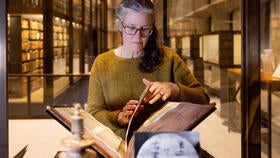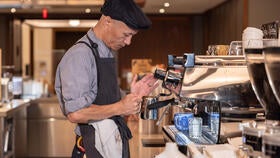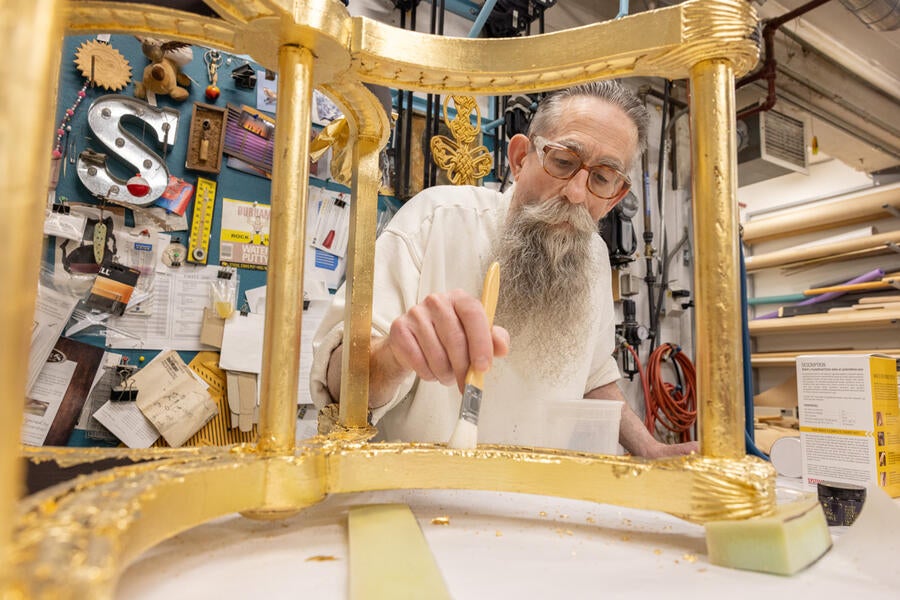
Behind the stage of the University Theatre on York Street sits a small properties (props) shop. Packed with a variety of hand and power tools and active projects, it is where David Schrader creates all manner of props, special effects, or set dressings for Yale Repertory Theatre stage productions.
As a properties craftsperson, Schrader has built, modified, and installed props at the David Geffen School of Drama for over 35 years. On a recent day, he was gold leafing a stool using a natural-bristled paint brush and a smaller goat hairbrush for the more delicate work. Schrader, taking inspiration from a photo of the real thing, was transforming the wooden stool frame into a faux-giltwood Louis XV seat.
The imitation gold leaf sheets, made of a variety of metals hammered paper thin, add a bit of glamour to the brown, x-frame stool. Each sheet is so light and airy that an expert hand and a lot of patience are needed while applying.
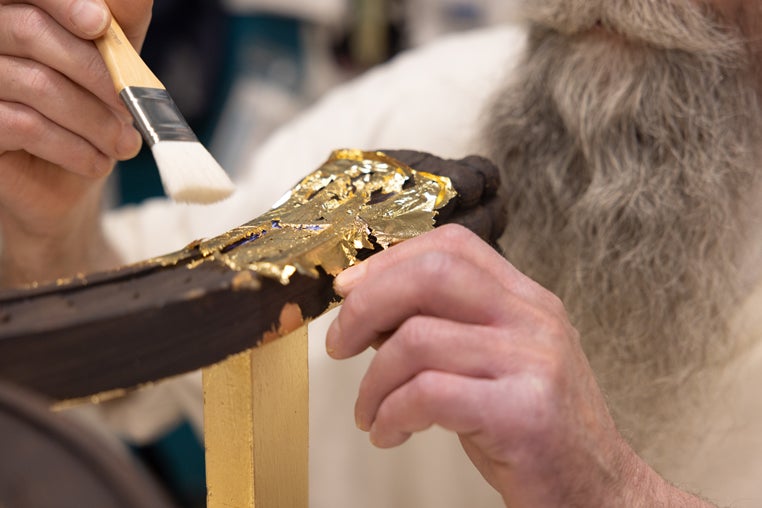 The imitation gold leaf sheets, made of a variety of metals hammered paper thin, add a bit of glamour to the brown, x-frame stool.
The imitation gold leaf sheets, made of a variety of metals hammered paper thin, add a bit of glamour to the brown, x-frame stool.
Using a nylon artist’s paint brush, Schrader spread some blue water-based adhesive called size on a small area of the stool. While it dried, he rubbed the larger bristled brush on his sleeve, creating some static, and gently lifted one shiny gossamer sheet (using the staticky brush), laying it on the stool’s curved leg. He gently worked the gold leaf onto the wooden surface, smoothing it with circular brush strokes.
When finished, the reinvented stool, complete with new cushion, will be used in a fall production. Schrader works closely with the show’s props manager, set designer, and director, who develop a property list for each stage show.
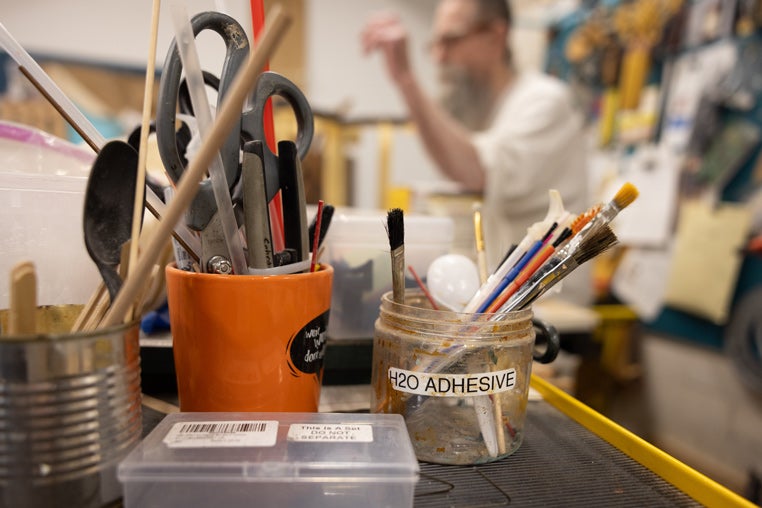 Various brushes Schrader uses to create props.
Various brushes Schrader uses to create props.
“The design process involves the show’s director deciding how they want to stage a play. The props list may change as rehearsals develop, and communication is important. I’m responsible for executing projects primarily for the Yale Repertory Theatre and sometimes for student productions at David Geffen School of Drama,” said Schrader.
Schrader’s “office,” the props shop, is equipped to build items ranging from large pieces like furniture and wooden trees to smaller items like pillows, glassware, and gardening tools. Schrader also has access to a warehouse of stock props maintained by the Geffen School of Drama. It includes furniture, soft goods, fixtures, paintings, drapery, and other accessories.
Actors interact with props during a show, and each production has specific needs. Schrader works closely with the properties supervisor and the properties associate to fill those needs. Schrader may work on a variety of jobs, including upholstering couches, staining tables, or crafting fake food or artificial shrubs. He also helps with set dressing—filling bookcases with books and objects and arranging flowers or rugs directly on the stage.
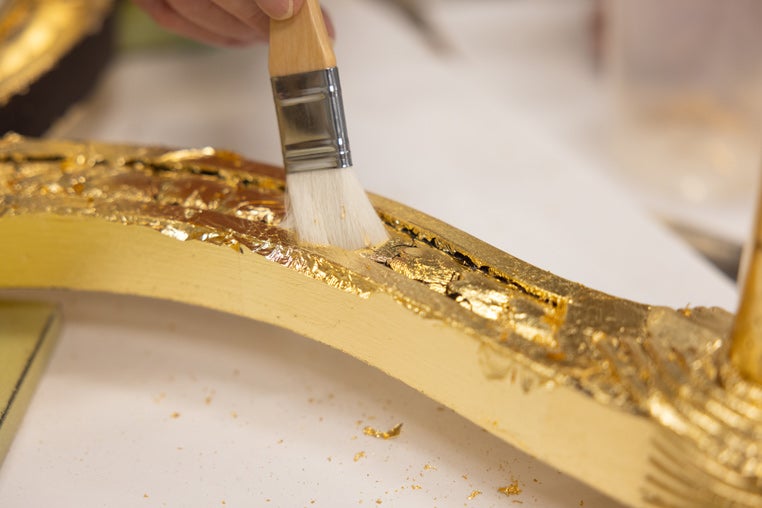 The reinvented stool, complete with new cushion, will be used in a fall production.
The reinvented stool, complete with new cushion, will be used in a fall production.
At the direction of the props manager, Schrader often refurbishes stored items (in the case of the x-frame stool) slated for future use. He will do some research, depending on the production’s era, to ensure the piece’s authenticity, noting that “the stage props help establish the play’s setting.” He sometimes visits rehearsals to see how his work fits within the final production.
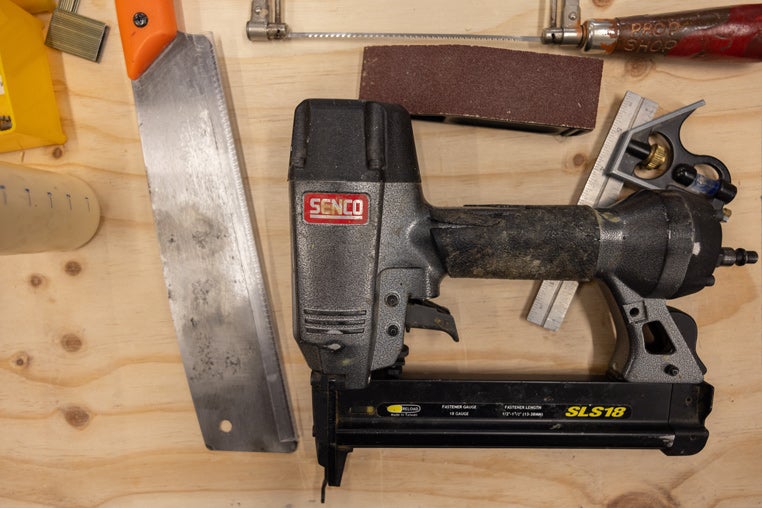 The handsaws and crown stapler Schrader uses to build props for productions at Yale Repertory Theatre stage productions.
The handsaws and crown stapler Schrader uses to build props for productions at Yale Repertory Theatre stage productions.
“It is so rewarding when someone comes to me with a new concept that I must create from scratch. It’s especially gratifying when the designer loves it. It enhances the actor’s performance, and works well with the overall staging,” said Schrader.
Schrader, who grew up in Iowa, spent many weekends on his grandparents’ farm fixing, refinishing, and upholstering furniture he found in their attic. What started as a hobby came in handy when he changed his college major from teaching to theatre. Today, Schrader “loves to make things with his hands,” enjoys working with the students, and learning new crafts—recently adding quilting to his repertoire. “Our students come from all over the world and have various experiences. It’s satisfying to interact with them and understand their interests and why they came here; we learn from each other.”




